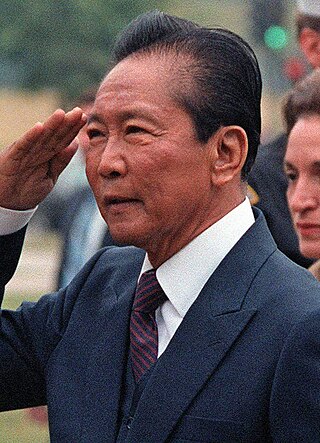
Ferdinand Emmanuel Edralin Marcos Sr. was a Filipino politician, lawyer, dictator, and kleptocrat who was the 10th president of the Philippines from 1965 to 1986. He ruled under martial law from 1972 until 1981 and kept most of his martial law powers until he was deposed in 1986, branding his rule as "constitutional authoritarianism" under his Kilusang Bagong Lipunan. One of the most controversial leaders of the 20th century, Marcos's rule was infamous for its corruption, extravagance, and brutality.

The president of the Philippines is the head of state, head of government and chief executive of the Philippines. The president leads the executive branch of the Philippine government and is the commander-in-chief of the Armed Forces of the Philippines.

The People Power Revolution, also known as the EDSA Revolution or the February Revolution, was a series of popular demonstrations in the Philippines, mostly in Metro Manila, from February 22 to 25, 1986. There was a sustained campaign of civil resistance against regime violence and electoral fraud. The nonviolent revolution led to the departure of Ferdinand Marcos, the end of his 20-year dictatorship and the restoration of democracy in the Philippines.
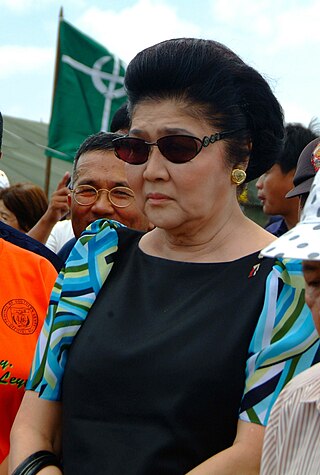
Imelda Romualdez Marcos is a Filipino politician who served as the First Lady of the Philippines from 1965 to 1986, wielding significant political power during the presidency of her husband, 10th president Ferdinand Marcos. She is the mother of current president Bongbong Marcos.

The vice president of the Philippines is the second-highest official in the executive branch of the Philippine government and is the first in the presidential line of succession. The vice president is directly elected by the people and is one of only two nationally elected executive officials, the other being the president.
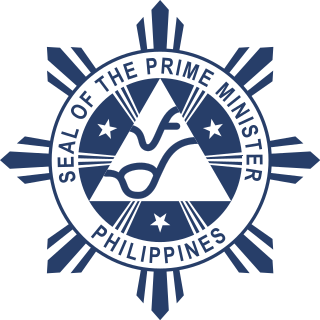
The prime minister of the Philippines was the official designation of the head of the government of the Philippines from 1978 until the People Power Revolution in 1986. During martial law and the fourth republic, the prime minister served as the head the Armed Forces of the Philippines. A limited version of this office, officially known as the President of the Council of Government, existed temporarily in 1899 during the First Philippine Republic.

The 7th Congress of the Philippines, composed of the Philippine Senate and House of Representatives, met from January 26, 1970, until September 23, 1972, during the fifth, sixth, and seventh years of Ferdinand Marcos's presidency. On September 23, 1972, President Marcos effectively dissolved the Congress with his declaration of martial law. Marcos then exercised legislative powers. In 1976, Congress was replaced by the Batasang Bayan as the Philippines' legislative body until 1978, when it was replaced by the Batasang Pambansa.
The Interim Batasang Pambansa was the legislature of the Republic of the Philippines from its inauguration on June 12, 1978, to June 5, 1984. It served as a transitional legislative body mandated by the 1973 Constitution as the Philippines shifted from a presidential to a semi-presidential form of government.
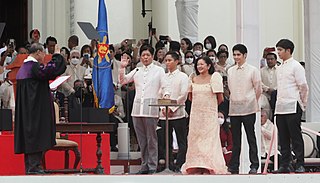
The inauguration of the president of the Republic of the Philippines is a ceremony marking the commencement of the six-year term of a president of the Philippines, who is both head of state and head of government. The inauguration is performed on June 30, as mandated by the 1987 Constitution. Under the older 1935 Constitution, the date was December 30, which is also Rizal Day; the last inauguration held on the older date was Ferdinand Marcos' second one on December 30, 1969. The most recent public presidential inauguration ceremony was that of President Bongbong Marcos, who began his six-year term in office on Thursday, June 30, 2022.

The 1969 Philippine presidential and vice presidential elections were held on November 11, 1969. Incumbent President Ferdinand Marcos won a second full term as President of the Philippines. Marcos was the last president in the entire electoral history of the Philippines who ran for and won a second term. His running mate, incumbent Vice President Fernando Lopez, was also elected to a third full term as Vice President of the Philippines. A total of twelve candidates ran for president, but ten of those got less than 0.01% of the vote.
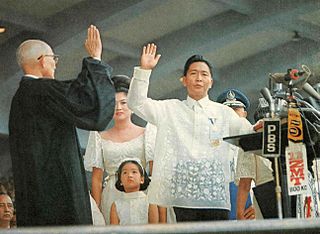
The first inauguration of Ferdinand E. Marcos as the tenth President of the Philippines took place on December 30, 1965 at the Quirino Grandstand in Manila. The inauguration marked the beginning of the first four-year term of Ferdinand Marcos as President and second four-year term of Fernando Lopez as Vice President. The oath of office was administered by Chief Justice of the Supreme Court of the Philippines César Bengzon. Marcos swore his oath on two closed family Bibles, one owned by his father Mariano and another given by his wife Imelda. One of the Bibles would later be used in the inauguration of his son Ferdinand Jr. in 2022.

The fourth inauguration of Ferdinand Marcos as the tenth President of the Philippines took place on February 25, 1986, at Malacañang Palace in Manila. The inauguration marked the commencement of the fourth term of Ferdinand Marcos as President. Marcos eventually stepped down as President a few hours later while the 3-day mass demonstrations were taking place.
1969 in the Philippines details events of note that happened in the Philippines in 1969.

The third inauguration of Ferdinand E. Marcos as the tenth president of the Philippines and that saw Ferdinand Marcos inaugurated for the third time took place on June 30, 1981, at the Quirino Grandstand in Manila, making it the first Philippine presidential inauguration to take place on June 30. The oath of office was administered by Chief Justice of the Supreme Court of the Philippines Enrique Fernando. The inauguration had then U.S. Vice President George H. W. Bush, Singaporean Prime Minister Lee Kuan Yew, future President of China Yang Shangkun and Thai Prime Minister Prem Tinsulanonda in attendance. This is when Bush made the infamous praise for Marcos: "We love your adherence to democratic principles and to the democratic process." The inauguration ceremonies started at 6:50 AM PST (GMT+8) to avoid the heat and afternoon rains. The inauguration was also televised live.

Ferdinand Marcos was inaugurated to his first term as the 10th president of the Philippines on December 30, 1965. His inauguration marked the beginning of his two-decade long stay in power, even though the 1935 Philippine Constitution had set a limit of only two four-year terms of office. Marcos had won the Philippine presidential election of 1965 against the incumbent president, Diosdado Macapagal.
The 1969 reelection campaign of Ferdinand Marcos, the 10th president of the Philippines, started in July 1969 when incumbent President Ferdinand Marcos was unanimously nominated as the Presidential candidate of the Nacionalista Party, and concluded when the 1969 Philippine presidential election concluded with Marcos winning an unprecedented second full term as President of the Philippines. With Fernando Lopez as his vice president, he ran against the Liberal Party slate of Sergio Osmena Jr. and Genaro Magsaysay.

Ferdinand Marcos' second term as President of the Philippines began on December 30, 1969, as a result of his winning the 1969 Philippine presidential election on November 11, 1969. Marcos was the first and last president of the Third Philippine Republic to win a second full term. The end of Marcos' second term was supposed to be in December 1973, which would also have been the end of his presidency because the 1935 Constitution of the Philippines allowed him to have only two four-year terms. However, Marcos issued Proclamation 1081 in September 1972, placing the entirety of the Philippines under Martial Law and effectively extending his term indefinitely. He would only be removed from the presidency in 1986, as a result of the People Power Revolution.
The 1969 Philippine balance of payments crisis was a currency crisis experienced by the Philippine economy as a result of heavy government spending linked to Ferdinand Marcos' campaign for his second presidential term in 1969. It was notable for being the first major economic crisis of the Marcos Administration, and for triggering the social unrest which was the rationalization for the proclamation of martial law in 1972.














